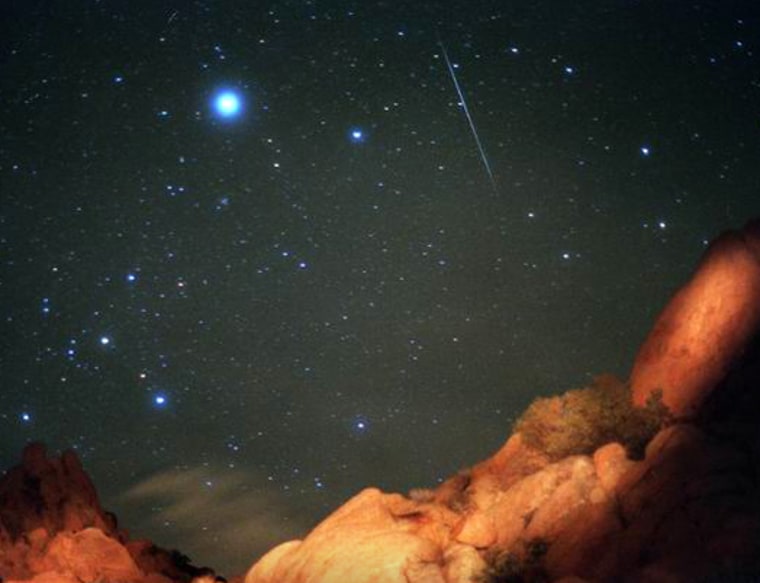Here are some of the more noteworthy sky events that will take place this year. SPACE.com's weekly Night Sky column will provide more extensive coverage of each event as they draw closer.
Jan. 3: Quadrantid Meteors. Circle this date on your calendar, for on this morning a strong display of Quadrantid meteors is possible for North America. In the United States and Canada, western observers are favored, for maximum activity is expected within a few hours of 5 a.m. PST. Recognized as a rich, but elusive shower, the "Quads" at greatest activity are capable of producing anywhere from 15 to perhaps 120 shower members per hour.
Feb. 22-26: Planet Trio. Early risers will have a chance to see a gathering of Jupiter (magnitude –2.0), Mercury (-0.1) and Mars (+1.2) within a 5-degree circle. Perhaps about a half-hour or so before sunrise you can catch a glimpse of Jupiter and Mercury hovering just above the horizon. Mars, however, likely will be much more difficult to spot against the twilight glow unless you use binoculars. The imaginary circle containing the three planets is smallest (3.7-degrees wide) on Feb. 24. On the mornings of Feb. 22 and 23, a very slender crescent moon will interact with these three planets in a most interesting manner.
March 25: Venus is both an Evening and Morning Star. Venus goes through an eight-year cycle of apparitions, meaning its behavior this year closely duplicates that in 2001, 1993, 1985, and on back. And only once per cycle do we in the Northern Hemisphere get a brief window of opportunity to glimpse Venus both at dusk and dawn on the same day. This will happen for several days, centered on March 25.
April 22: Occultation of the planet Venus. Along the West Coast of the US, a very thin ( 8-percent illuminated) waning crescent moon will cross in front of Venus before sunrise. Farther east, this event occurs after sunrise.
June 6: Occultation of the star Antares. Late this evening, a waxing gibbous moon, only about 15 hours from full and 99 percent illuminated will occult the first-magnitude red supergiant star Antares. This occultation will be visible across much of the central and eastern US and parts of central Canada.
July 22: "Eclipse of the Century." The longest total solar eclipse in the 21st century will take place, as the moon's dark umbral shadow first touches down on the Arabian Sea then sweeps across sweeping northeast across central India, the southeast portion of Nepal, most of Bhutan, northern Bangladesh, extreme eastern India and southern and central Tibet. The umbra will then cut across the middle of China, then it moves out over the East China Sea and over some of the Ryukyu (or Nansei) Islands. About 200 mi (325 km) east-southeast of Iwo Jima is the point of greatest eclipse. For some, this may be the best eclipse of the 21st century, as it is the longest-lasting one to occur between 1991 and 2132.
Aug. 10 through Sept. 4: Saturn without rings. In contrast to 2003, when Saturn's ring system was tilted toward Earth at their maximum of nearly 27-degrees, the rings will be oriented more-or-less "edge-on" as viewed from Earth. This reason for this is due to the relative positions of Saturn, Earth, and sun. The rapid motion of Earth traveling in its orbit changes our viewing angle from a position of observing the southern face of the rings to the northern face and for an interval of more than three weeks, the famous rings will be virtually impossible to see.
Sept. 2-3: Jupiter without satellites. Anyone who points a small telescope toward the planet Jupiter will nearly always see some or all of the four famous Galilean satellites. Usually at least two or three of these moons are immediately evident; sometimes all four. It is very rare when only one moon is in view and rarer still when no moons at all are visible. Late on this night, for much of the Western Hemisphere, Jupiter will appear moonless for almost two hours.
Oct. 8: Very close conjunction of Mercury and Saturn. When they rise above the eastern horizon on this morning over North America, Mercury will appear only 0.3-degree below and to the right of Saturn. At magnitude –0.7, Mercury will appear nearly five times brighter than Saturn (magnitude +1.0). Actually, this very close pairing-off between Mercury and Saturn is only part of an ever-changing array that will also include Venus (magnitude –3.9). And on the morning of October 16, a very slender crescent moon, less than two days from new, slides well off to the south of the three planets.
Nov. 17: Leonid Meteors. A brief outburst of perhaps up to 500 meteors per hour is forecast to occur based on a joint prediction by astronomers from Caltech and NASA. The potential spectacle is expected sometime between 21:34 and 21:44 UT, which favors Asia.
Dec. 13-14: Geminid Meteors. A great year for these pre-Christmas celestial fireworks, with the moon only a couple of days from New phase and the prospects of up to sighting up to 120 meteors per hour.
